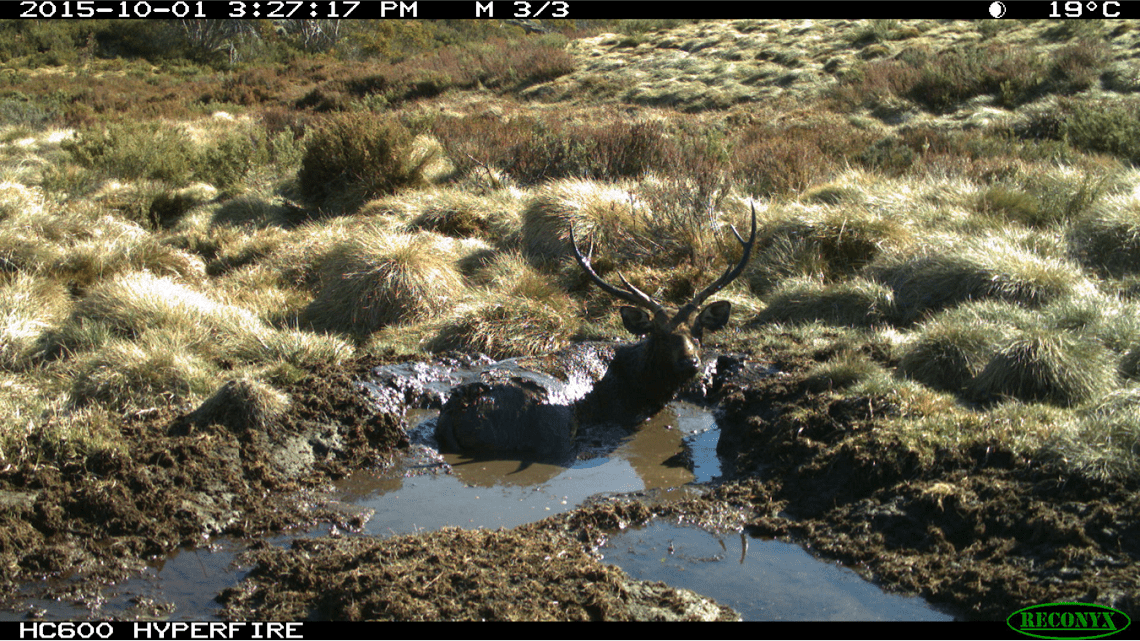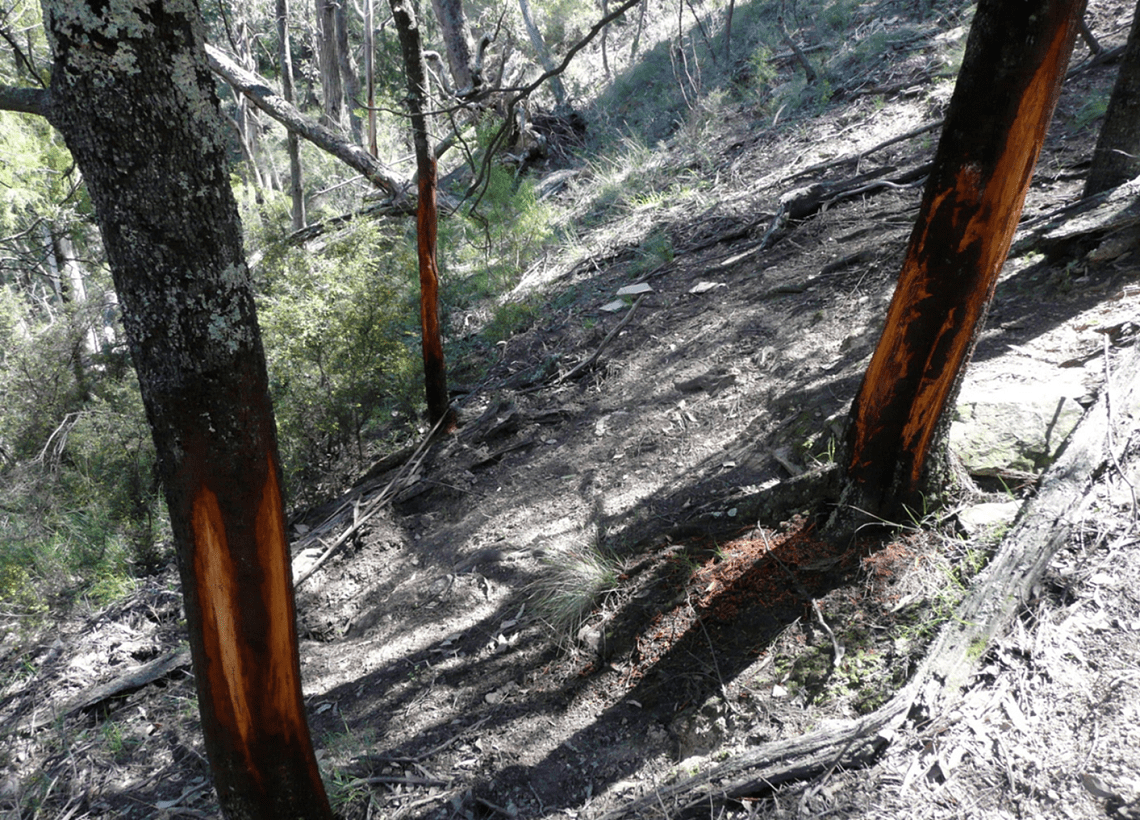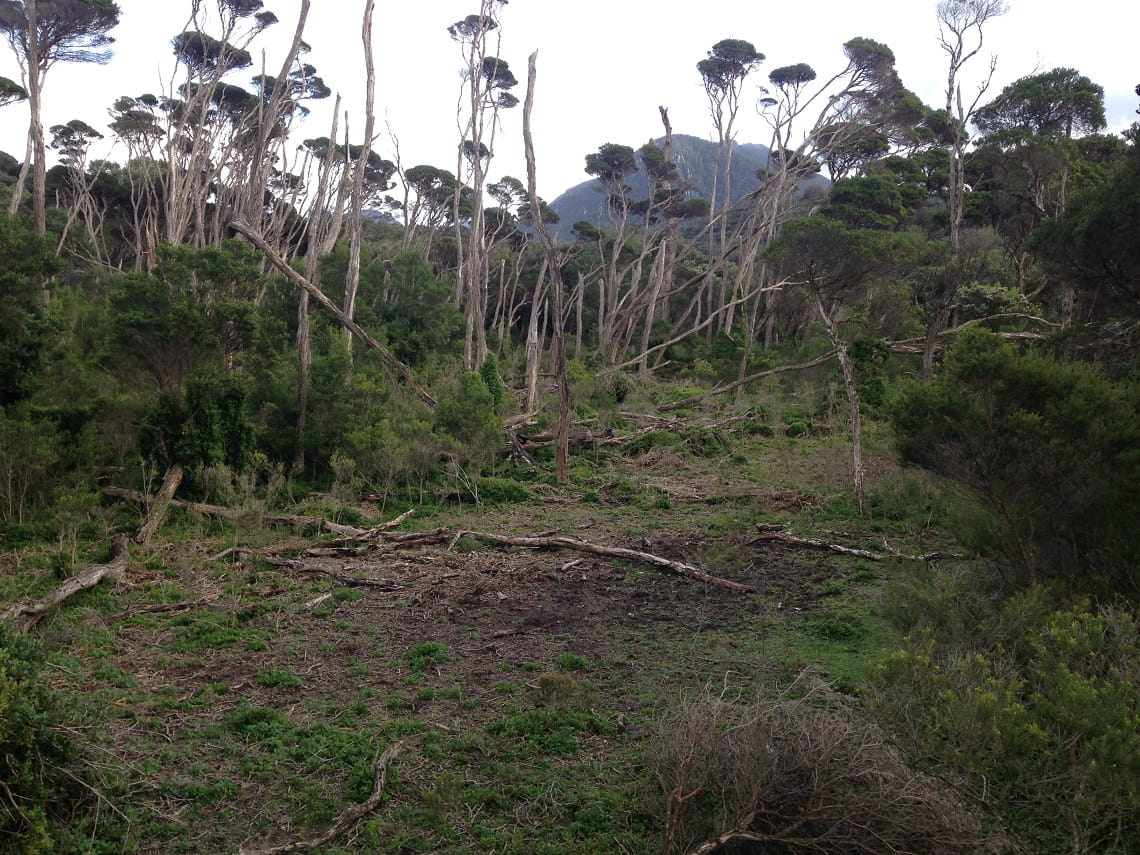Deer
Deer are not a natural part of the Australian environment. Parks Victoria manages deer in specific areas across the state to protect parks from environmental damage.
Deer can cause serious damage to native plants, animals and habitat by trampling and destroying plants, increasing grazing pressure, ring-barking young trees, fouling waterholes, causing soil erosion and spreading weeds.
In Victoria, established deer species are classified as ‘game’ under the Wildlife Act 1975. Most national, state, wilderness, coastal and regional parks are closed to hunting at all times. However, hunting is permitted in several protected areas, subject to various conditions For more information, visit www.parks.vic.gov.au/things-to-do/hunting.
Target areas for deer control
This is a map of target areas for Parks Victoria's statewide deer control program.
Our objective for deer management in each park is based on the area's conservation needs. In some parks we aim to reduce the population size, in some we aim to prevent damage to high biodiversity-value areas, and in some we aim to prevent new incursions from establishing.
Please check individual park pages to see whether deer control operations are underway, and for the latest information about closures and conditions.
Managing deer populations in Victoria
In 2021, the Victorian Government established the Victorian Deer Control Strategy to provide a clear and coordinated approach to deer control in Victoria. This strategy is Victoria’s plan to reduce the increasing and significant impacts growing deer numbers are having on the environment, agriculture, Aboriginal cultural heritage, and public safety. Parks Victoria is one of the many partners delivering on this strategy.
To reduce damage caused by deer and feral animals, Parks Victoria takes coordinated action, informed by scientific research, tailored to individual parks and target species.
Each deer control program is specifically designed to address conservation needs. In some areas it means reducing the population size, in others we target deer in high biodiversity-value areas, and in others we work to prevent new incursions from establishing. All our deer control programs are carried out in areas where deer control can be most effective in protecting the most important values.
Each conservation program is one of hundreds of programs across Victoria using available tools to protect nature and care for Country.
All Parks Victoria’s conservation programs are thoroughly planned and implemented under strict protocols and oversight, ensuring that operations are safe, effective, humane and meet obligations of all relevant legislation, Codes of Practice and Standard Operating Procedures.
The most effective method for controlling deer populations is shooting.
Ground shooting
Deer are managed in parks through targeted ground-shooting by contractors and qualified volunteers.
In many parks, ground shooting programs target a range of species, not just deer. These can include pigs goats and foxes. Targeting a range of species benefits native species including threatened plants, plant communities and animals, and park landscapes.
In general, deer carcasses will be left where they fall. Shooters will avoid shooting animals in wetlands or waterways or close to walking and/or vehicle tracks. If this is not possible carcasses will be broken up and moved. In areas where they have no impact on visual amenity or water quality, deer carcasses will be left where they fall.
Aerial shooting
In some parks, deer are also managed using aerial shooting by specialist contractors. Aerial shooting is an appropriate, effective and humane method of control across large and remote areas which are difficult or unsafe to access by foot.
In addition to deer, Parks Victoria’s aerial shooting programs may also target feral pigs, feral goats and feral cattle.
Partial closures will be in place for parks where aerial shooting is planned. Please check individual park webpages for the latest information about closures and conditions.
Fencing
In some places, small-scale exclusion areas are fenced to protect small vulnerable habitats from damage by deer.
Impacts to park visitors
When planning your park visit, please visit the specific park webpages for the latest information about closures and conditions in each park.
Keeping visitors informed
- At the start of each deer control program, every effort is made to advise all key stakeholders including neighbours, Licensed Tour Operators and school groups of Parks Victoria’s intent to undertake deer control and proposed locations.
- Advisory signs are placed in parks to inform visitors that deer control work is being carried out in the area. These are installed at the start of the program and removed at the end.
Access for visitors and hunters
- Ground shooting is often undertaken at night and does not impact people's ability to visit parks.
- Generally, parks are not closed for ground shooting however, there may be other factors impacting visitors’ ability to access parks. Please check individual park webpages for the latest information about closures and conditions.
- Partial closures will be in place for parks where aerial shooting is planned. Please check individual park webpages for the latest information about closures and conditions.
- While aerial shooting is underway, people nearby may see helicopters and hear gunshots.
- Parks Victoria’s deer control programs aim to reduce deer activity around significant environment values that are vulnerable to deer impacts. Therefore, they have little impact on people’s ability to go hunting, and limited influence on people’s opportunity to shoot deer.
Obligations to manage deer
Parks Victoria has clear legal obligations to protect and manage Victoria’s natural environment, and specifically the parks estate. These obligations are set out in a range of legislation including:
- Parks Victoria Act 2018
- National Parks Act 1975 (Vic)
- Flora and Fauna Guarantee Act 1988 (Vic)
- Environment Protection and Biodiversity Conservation Act 1999 (Cth)
- International Ramsar Wetlands Convention
Currently in Victoria, established species of deer (Sambar, Fallow, Red and Hog) are classified as ‘game’ under the Wildlife Act 1975. But that doesn’t mean they cannot be controlled if they are causing damage. Parks Victoria acknowledges that these four species of deer are already established in the wild in Victoria and cannot be eradicated at a statewide level using current control methods.
Deer damage Victoria’s natural environment
For millions of years, Victoria's native plants and animals evolved to survive in our unique environments, without the impacts of feral animals. Victoria’s native plants and animals, many of which are found nowhere else on the planet, are not equipped to deal with the environmental impacts of deer – stretching from the coastline up into the Alps and almost everywhere in between.
The introduction of the Victorian Deer Control Strategy provides more detail about the impacts of deer on Victoria’s biodiversity, agriculture, public safety, Aboriginal cultural heritage and Melbourne’s water supply.
There are many examples of deer damage in Victoria's parks.

Deer wallowing in native vegetation.

Deer rubbings on young trees.

Deer damage in the Alpine National Park.
Scientific papers about deer impacts in Australia and New Zealand
Côté S. D., Rooney T. P., Tremblay J. P., Dussault C. and Waller D. M. (2004) Ecological impacts of deer overabundance. Annual Review of Ecology Evolution and Systematics 35: 113-47.
Downes M. C. (1983) The Forest Deer Project 1982: a report to the Forests Commission Victoria. Australian Deer Research Foundation, Melbourne, Victoria.
Ethos NRM (2019) Monitoring Changes in the Levels of Deer Abundance and Impacts in the Alpine National Park 2015-2020, Summary Report 2019, Bogong High Plains. A report prepared for Parks Victoria.
Ethos NRM (2020) Monitoring Changes in the Levels of Deer Abundance and Impacts in the Alpine National Park 2015-2020, Summary Report 2020, Howitt-Wellington Plains. A report prepared for Parks Victoria.
Eyles D. (2002) Sambar Deer (Cervus unicolor) as a potential seed vector for the spread of the environmental weed Himalayan Honeysuckle (Leycesteria formosa) at Mount Buffalo National Park. Honours thesis, University of Melbourne, Melbourne.
Forsyth, D.M. (2006) A monitoring program for deer in Alpine National Park and surrounding areas. Parks Victoria, Melbourne.
Forsyth, D.M., Ransey, D.S.L., Veltman, C.J., Allen, R.B., Allen, W.J., Barker, R.J., Jacobson, C.L., Nicol, S.J., Richardson, S.J. and Todd, C.R. (2013) When deer must die: large uncertainty surrounds changes in deer abundance achieved by helicopter- and ground based hunting in New Zealand forests. Wildlife Research 40: 447-458.
Gill R. M. A. and Beardall V. (2001) The impact of deer on woodlands: the effects of browsing and seed dispersal on vegetation structure and composition. Forestry 74: 209-218.
Hall G. P. and Gill K. P. (2005) Management of wild deer in Australia.Journal of Wildlife Management 69: 837-844.
Kumbasli M., Makineci E. and Cakir M. (2010) Long term effects of red deer (Cervus elaphus) grazing on soil in a breeding area. Journal of Environmental Biology 185-188.
Peel B., Bilney R. J. and Bilney R. J. (2005) Observations of the ecological impacts of sambar Cervus unicolor in East Gippsland, Victoria, with reference to destruction of rainforest communities. The Victorian Naturalist 122: 189-200.
Sharp, T. and Saunders, G. (2008) A model for assessing the relative humaneness of pest animal control methods, Australian Government Department of Agriculture, Fisheries and Forestry, Canberra, available from http://www.feral.org.au/animal-welfare/humane-codes/.
Tolsma (2009) An Assessment of Mossbeds Across the Victorian Alps, 2004-2009. Report to Parks Victoria. Arthur Rylah Institute for Environmental Research, Heidelberg.
Past programs
Deer and feral animal control in response to bushfire
This was the largest and longest coordinated animal control program in Victoria’s history.
Following the 2019-20 bushfires, Parks Victoria and the Department of Energy, Environment and Climate Action (DEECA) implemented a large-scale, coordinated deer and feral animal control program in parks and reserves across Eastern Victoria and Budj Bim National Park in Western Victoria.
The aim of this program was to remove deer and feral animals from priority fire-affected and adjacent areas, giving native plants, plant communities and animals the best chance of recovery.
The 2019-20 bushfires had a devastating impact on native species and large areas of habitat in Victoria. Under these conditions, deer and feral animals are a significant threat to survival and recovery as they seriously damage native vegetation and important habitat areas through grazing, browsing, trampling and wallowing.
This work was funded by the Victorian Government’s Bushfire Biodiversity Response and Recovery program.
For more detail, see past program updates:
- September 2021: Large-scale and long-term action is best for the environment
- December 2020: Giving biodiversity a fighting chance
- July 2020: Promising signs of wildlife recovery in eastern Victoria

